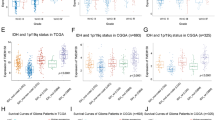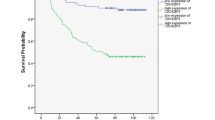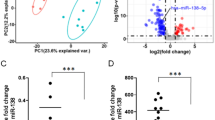Abstract
The migration and invasion inhibitor protein (MIIP, also known as IIp45) was discovered as a negative regulator of cell migration and invasion in glioma. Our previous studies have shown that the MIIP protein was reduced or undetectable in some tissue samples obtained from patients with glioblastoma. The significance of MIIP in gliomagenesis is unknown. In this study, we report that MIIP has an important role in the inhibition of gliomagenesis and attenuation of mitotic transition. Increased MIIP expression levels inhibited colony formation and cell growth of glioma cell lines in vitro, whereas decreased expression by specific small interfering RNA for MIIP resulted in increased cell growth. Expression of MIIP in a glial-specific mouse model blocked glioma development and progression, thus showing that MIIP is an inhibitor of gliomagenesis. Furthermore, we show that MIIP attenuates mitotic transition and results in increased mitotic catastrophe. The biochemical mechanism of MIIP in this process is associated with its regulation of anaphase-promoting complex (APC/C) activity. MIIP interacts directly with Cdc20, and the interaction of MIIP with Cdc20 inhibits APC/C-mediated degradation of cyclin B1. Thus, MIIP attenuates mitotic transition and increases mitotic catastrophe, thereby inhibiting glioma development and progression.
This is a preview of subscription content, access via your institution
Access options
Subscribe to this journal
Receive 50 print issues and online access
$259.00 per year
only $5.18 per issue
Buy this article
- Purchase on Springer Link
- Instant access to full article PDF
Prices may be subject to local taxes which are calculated during checkout






Similar content being viewed by others
References
Behin A, Hoang-Xuan K, Carpentier AF, Delattre JY . (2003). Primary brain tumours in adults. Lancet 361: 323–331.
Demuth T, Berens ME . (2004). Molecular mechanisms of glioma cell migration and invasion. J Neurooncol 70: 217–228.
Dunlap SM, Celestino J, Wang H, Jiang R, Holland EC, Fuller GN et al. (2007). Insulin-like growth factor binding protein 2 promotes glioma development and progression. Proc Natl Acad Sci USA 104: 11736–11741.
Fang G, Yu H, Kirschner MW . (1998). Direct binding of CDC20 protein family members activates the anaphase-promoting complex in mitosis and G1. Mol Cell 2: 163–171.
Fraschini R, Formenti E, Lucchini G, Piatti S . (1999). Budding yeast Bub2 is localized at spindle pole bodies and activates the mitotic checkpoint via a different pathway from Mad2. J Cell Biol 145: 979–991.
Fujita T, Igarashi J, Okawa ER, Gotoh T, Manne J, Kolla V et al. (2008). CHD5, a tumor suppressor gene deleted from 1p36.31 in neuroblastomas. J Natl Cancer Inst 100: 940–949.
Gibbs M, Stanford JL, McIndoe RA, Jarvik GP, Kolb S, Goode EL et al. (1999). Evidence for a rare prostate cancer-susceptibility locus at chromosome 1p36. Am J Hum Genet 64: 776–787.
Hoffman S, Propp JM, McCarthy BJ . (2006). Temporal trends in incidence of primary brain tumors in the United States, 1985-1999. Neuro Oncol 8: 27–37.
Holland EC, Hively WP, DePinho RA, Varmus HE . (1998). A constitutively active epidermal growth factor receptor cooperates with disruption of G1 cell-cycle arrest pathways to induce glioma-like lesions in mice. Genes Dev 12: 3675–3685.
Homer HA, McDougall A, Levasseur M, Murdoch AP, Herbert M . (2005). Mad2 is required for inhibiting securin and cyclin B degradation following spindle depolymerisation in meiosis I mouse oocytes. Reproduction 130: 829–843.
Janoueix-Lerosey I, Novikov E, Monteiro M, Gruel N, Schleiermacher G, Loriod B et al. (2004). Gene expression profiling of 1p35-36 genes in neuroblastoma. Oncogene 23: 5912–5922.
Li Y, Benezra R . (1996). Identification of a human mitotic checkpoint gene: hsMAD2. Science 274: 246–248.
Maher EA, Furnari FB, Bachoo RM, Rowitch DH, Louis DN, Cavenee WK et al. (2001). Malignant glioma: genetics and biology of a grave matter. Genes Dev 15: 1311–1333.
Miller JJ, Summers MK, Hansen DV, Nachury MV, Lehman NL, Loktev A et al. (2006). Emi1 stably binds and inhibits the anaphase-promoting complex/cyclosome as a pseudosubstrate inhibitor. Genes Dev 20: 2410–2420.
Munirajan AK, Ando K, Mukai A, Takahashi M, Suenaga Y, Ohira M et al. (2008). KIF1Bbeta functions as a haploinsufficient tumor suppressor gene mapped to chromosome 1p36.2 by inducing apoptotic cell death. J Biol Chem 283: 24426–24434.
Nilsson J, Yekezare M, Minshull J, Pines J . (2008). The APC/C maintains the spindle assembly checkpoint by targeting Cdc20 for destruction. Nat Cell Biol 10: 1411–1420.
Ohgaki H, Kleihues P . (2005). Population-based studies on incidence, survival rates, and genetic alterations in astrocytic and oligodendroglial gliomas. J Neuropathol Exp Neurol 64: 479–489.
Peschiaroli A, Dorrello NV, Guardavaccaro D, Venere M, Halazonetis T, Sherman NE et al. (2006). SCFbetaTrCP-mediated degradation of Claspin regulates recovery from the DNA replication checkpoint response. Mol Cell 23: 319–329.
Ragnarsson G, Eiriksdottir G, Johannsdottir JT, Jonasson JG, Egilsson V, Ingvarsson S . (1999). Loss of heterozygosity at chromosome 1p in different solid human tumours: association with survival. Br J Cancer 79: 1468–1474.
Reimann JD, Gardner BE, Margottin-Goguet F, Jackson PK . (2001). Emi1 regulates the anaphase-promoting complex by a different mechanism than Mad2 proteins. Genes Dev 15: 3278–3285.
Smith JS, Alderete B, Minn Y, Borell TJ, Perry A, Mohapatra G et al. (1999). Localization of common deletion regions on 1p and 19q in human gliomas and their association with histological subtype. Oncogene 18: 4144–4152.
Song F, Ji P, Zheng H, Wang Y, Hao X, Wei Q et al. (2010). Definition of a functional single nucleotide polymorphism in the cell migration inhibitory gene MIIP that affects the risk of breast cancer. Cancer Res 70: 1024–1032.
Song MS, Song SJ, Ayad NG, Chang JS, Lee JH, Hong HK et al. (2004). The tumour suppressor RASSF1A regulates mitosis by inhibiting the APC-Cdc20 complex. Nat Cell Biol 6: 129–137.
Song SW, Fuller GN, Khan A, Kong S, Shen W, Taylor E et al. (2003). IIp45, an insulin-like growth factor binding protein 2 (IGFBP-2) binding protein, antagonizes IGFBP-2 stimulation of glioma cell invasion. Proc Natl Acad Sci USA 100: 13970–13975.
Song SW, Fuller GN, Zheng H, Zhang W . (2005). Inactivation of the invasion inhibitory gene IIp45 by alternative splicing in gliomas. Cancer Res 65: 3562–3567.
Tang Z, Shu H, Oncel D, Chen S, Yu H . (2004). Phosphorylation of Cdc20 by Bub1 provides a catalytic mechanism for APC/C inhibition by the spindle checkpoint. Mol Cell 16: 387–397.
Wolthuis R, Clay-Farrace L, van Zon W, Yekezare M, Koop L, Ogink J et al. (2008). Cdc20 and Cks direct the spindle checkpoint-independent destruction of cyclin A. Mol Cell 30: 290–302.
Wu Y, Song SW, Sun J, Bruner JM, Fuller GN, Zhang W . (2010). IIp45 inhibits cell migration through inhibition of HDAC6. J Biol Chem 285: 3554–3560.
Yamano H, Gannon J, Mahbubani H, Hunt T . (2004). Cell cycle-regulated recognition of the destruction box of cyclin B by the APC/C in Xenopus egg extracts. Mol Cell 13: 137–147.
Yu H . (2007). Cdc20: a WD40 activator for a cell cycle degradation machine. Mol Cell 27: 3–16.
Acknowledgements
We thank Kanchana Natarajan-Mendes for her contribution to the cell-cycle assays in this study, and Hong Zheng for her technical assistance. We thank Drs Ying Wu, Limei Hu and Paul Chiao for critically reviewing the manuscript and providing valuable comments. We gratefully thank Dr Kate J Newberry at the Department of Scientific Publications of MD Anderson Cancer Center for editing this paper. This study was partially supported by an ARP Grant from the Texas Higher Education Coordinating Board, the Anthony Bullock Brain Tumor Research Fund and NIH grant RO1 CA98503 (to WZ and GNF). We also thank the National Foundation for Cancer Research, the Goldhirsh Foundation, the James S McDonnell Foundation and the Oreffice Foundation for their support. Sarah M Smith (formerly Sarah M Dunlap) was supported by an NIH Pharmacoinformatics Training Fellowship and an American Legion Fellowship.
Author information
Authors and Affiliations
Corresponding author
Ethics declarations
Competing interests
The authors declare no conflict of interest.
Rights and permissions
About this article
Cite this article
Ji, P., Smith, S., Wang, Y. et al. Inhibition of gliomagenesis and attenuation of mitotic transition by MIIP. Oncogene 29, 3501–3508 (2010). https://doi.org/10.1038/onc.2010.114
Received:
Revised:
Accepted:
Published:
Issue Date:
DOI: https://doi.org/10.1038/onc.2010.114
Keywords
This article is cited by
-
Proliferation-Related Features of the Human Mesenchymal Stem Cells Derived from Palatine Tonsils, Adipose Tissues, and Bone Marrow
Tissue Engineering and Regenerative Medicine (2023)
-
MIIP functions as a novel ligand for ITGB3 to inhibit angiogenesis and tumorigenesis of triple-negative breast cancer
Cell Death & Disease (2022)
-
MIIP inhibits the growth of prostate cancer via interaction with PP1α and negative modulation of AKT signaling
Cell Communication and Signaling (2019)
-
MiRNA-646-mediated reciprocal repression between HIF-1α and MIIP contributes to tumorigenesis of pancreatic cancer
Oncogene (2018)
-
Distinct subgroup of the Ras family member 3 (DIRAS3) expression impairs metastasis and induces autophagy of gastric cancer cells in mice
Journal of Cancer Research and Clinical Oncology (2018)



